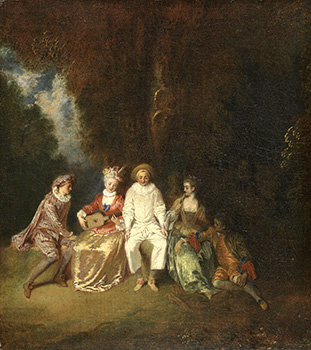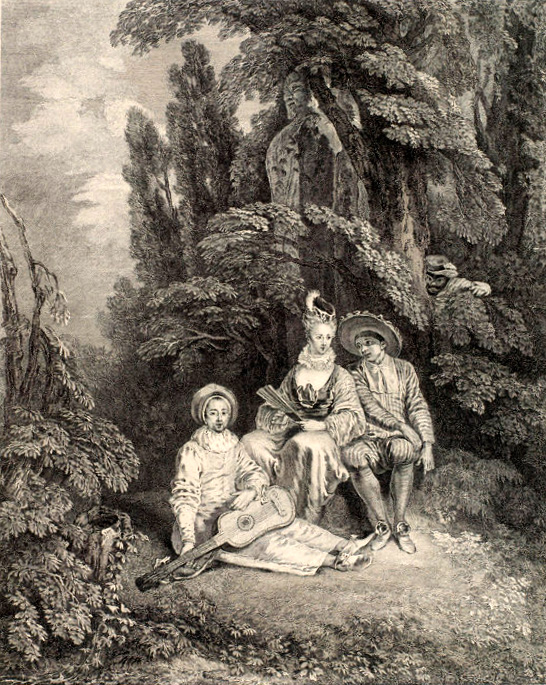
- Home Page
- Accepted
Paintings & Copies - Doubtful
Attributions - Doubtful Textual References
- Alternative
Titles - Collectors &
Museums - Bibliography
- Search Abecedario
- Watteau &
His Circle
Les Jaloux
Entered November 2023
Presumed lost
Oil on panel
30.5 x 33 cm
ALTERNATIVE TITLES
L’Intérieur d’un Jardin
RELATED PRINTS
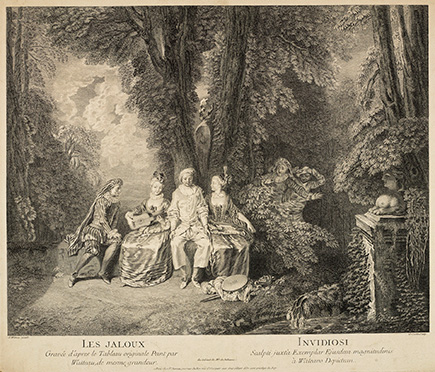
Gérard Scotin after Watteau, Les Jaloux, engraving, c. 1729.
Watteau’s Les Jaloux was engraved by Gérard Scotin before 1729. Scotin’s print is in the same direction as the original painting, as can be judged by its correspondence to Watteau’s preliminary drawings for the picture.
PROVENANCE
Paris, collection of Jean de Jullienne (1686-1766; director of a tapestry factory). Jullienne’s ownership is cited on the Scotin engraving: “du Cabinet de Mr de Julienne.” The picture was no longer in his collection by 1756, when an illustrated inventory of his collection was compiled; that manuscript is now in the Morgan Library & Museum, New York.
Paris, collection of Jean-Baptiste François de Montullé (1721-1787; magistrate). His sale, Paris, December 22ff, 1783, lot 56: “PAR LE MÊME [ANTOINE WATTEAU]. . . . L’intérieur d’un Jardin, sur le devant duquel on vit un Pierrot & un Mezetin assis entre deux femmes, dont l’une pince une guittarre; dans le fond & derriere un buisson on distigue un Arlequin & un Scaramouche qui les regardent attentivement. Hauteur 12 pouces, largeur 13 pouces. B.” According to the Getty Research Institute, the picture sold for 200 livres to Lebrun.
Paris, with Jean-Baptiste Pierre Lebrun (1748-1813; painter and art dealer).
Paris, sale, April 19 ff., 1786 [postponed until May 3, 1786], Morel collection and others, lot 143: “ANTOINE WATTEAU . . . Quatre figures sous un bosquet, faisant de la musique; l’on voit deux femmes assises sur un banc, l’une pince de la guittare, l’aute regarde un homme en habit de Pierrot, placé entr’elles deux; un autre homme vêtu en Scapin, paroit attentif au jeu de cellle qui pince de la guittare & auprès de laquelle il est assis, un tambour de basque est à leurs pieds; ce Tableau est d’un effet tout ensemble mystérieux & piquant par un heureux contraste de lumiere & d’ombre. Hauteur 11 pouces 5 lignes, largeur 13 pouces. B.” The picture sold for 129 livres to Vincent Michel Maynon de Farchville.
Paris, collection of Vincent Michel Maynon de Farchville (c. 1716 – c. 1805; Président au Parlement en la quarième chambre des enquêtes). His sale, Paris, April 28, 1806, lot 36: “Vatteau (Ant.) Figures dans un paysage, sur toile, Hauteur 11 pouces, largeur 13 pouces.”
SELECT BIBLIOGRAPHY
Mariette, “Notes manuscrites,” 9: fol. 193.
Hédouin, “Watteau” (1845), 79.
Hédouin, Mosaïque (1856), cat. 87.
Goncourt, L’Art au XVIIIème siècle (1860), 57.
Goncourt, Catalogue raisonné (1875), cat. 142.
Phillips, Watteau (1895), 24.
Fourcaud,“Scènes et figures théatrales” (1904), 193-94.
Dacier, Vuaflart, and Hérold, Jean de Jullienne et les graveurs (1921-29), 1: 84, 254; 2: 65, 94, 97, 122, 130; 3: 88, cat. 127.
Réau, “Watteau” (1928), cat. 67.
Adhémar, Watteau (1950), cat. 64.
Mathey, Watteau, peintures réapparues (1959), 67.
Eidelberg, Watteau’s Drawings (1965), 218.
Macchia and Montagni, L’opera completa di Watteau (1968), cat. 80.
Ferré, Watteau (1972), cat. B13.
Roland Michel, Watteau (1981), cat. 113.
Roland Michel, Watteau (1984), 25, 34, 69, 177, 215, 223, 266.
Washington, Paris, Berlin, Watteau 1684-1721 (1984), under cat. 13, 14.
Posner, Watteau (1984), 38, 56-58, 65-66, 150, 153.
Rosenberg and Prat, Watteau, Catalogue raisonné des dessins (1996), cat. 94, 100, 158, R 744.
Ottawa, National Gallery, The Great Parade (2004), 69.
Michel, Le «célèbre Watteau» (2008), 126, 169.
New York, Metropolitan Museum, Watteau, Music, and Theater (2009), 24.Kavanagh, Esthetics of the Moment (2015), 169.
Glorieux, Watteau (2011), 112-13.
Eidelberg, “Spoede, Gillot’s Forgotten Assistant“ (2020).
RELATED DRAWINGS
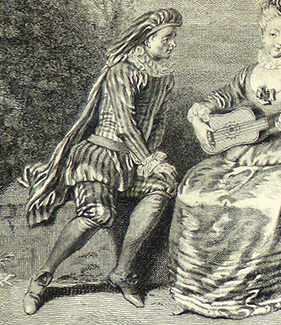
Gérard Scotin after Watteau, Les Jaloux (detail), engraving.
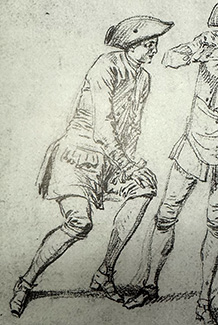
Watteau, Three Studies of a Man (detail), red chalk. New York, private collection.
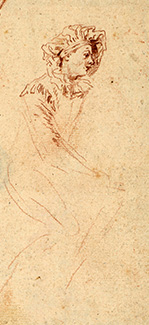
Watteau, Various Studies from the Model (detail), red chalk. Berlin, Staatlichen Museen, Kupferstichkabinett.
The Mezzetin at the left in Les Jaloux is a composite based on two otherwise unrelated Watteau drawings. The actor’s general pose—seated but swiveling to his left—was derived from a sheet of studies of a man in different attitudes, last recoded in a New York private collection (Rosenberg and Prat 100). Watteau repeated the model’s general pose but not his “civilian” clothing. Instead, he turned to a sheet of studies in Berlin (Rosenberg and Prat 158) where the head and torso of a Mezzetin is posed as in Les Jaloux and the New York drawing, but clothed in Mezzetin's costume. Also, the lower portion of the actor’s body is lightly indicated in the Berlin drawing, in essentially the same twisted pose as in Les Jaloux and the New York drawing.
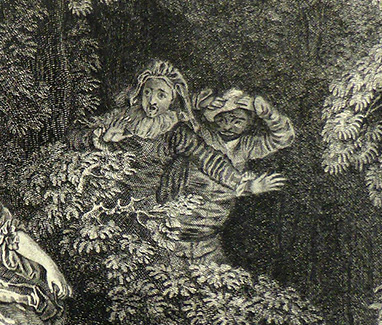
Gérard Scotin after Watteau, Les Jaloux (detail), engraving.
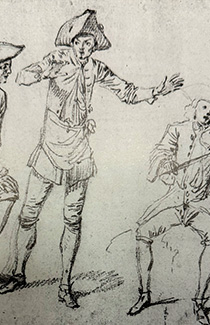
Watteau, Three Studies of a Man (detail), red chalk. New York, private collection
The Scramouche (or so he was identified in 1783) emerging from the bushes at the right of Les Jaloux was derived from the middle figure on the same sheet of studies in New York just discussed (Rosenberg and Prat 100). In this instance Watteau borrowed the figure of a standing model, his arms thrust forward in surprise. He repeated the man’s general pose and especially the open positioning of the fingers in the painting. However, as before, he replaced the man’s contemporary dress with the comedian’s standard stage costume.
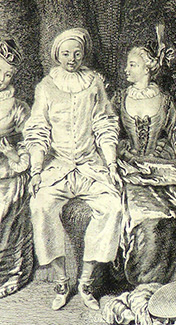
Gérard Scotin after Watteau, Les Jaloux (detail), engraving.
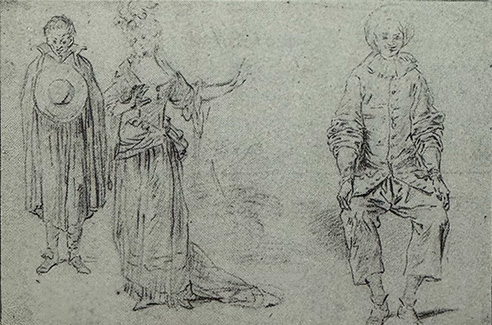
Unidentified artist after Watteau, Studies of Three Theatrical Characters, red chalk, 11.6 x 18.2 cm. Rouen, Musée des Beaux-arts.
Watteau’s original drawing for the figure of Pierrot has not survived, but its appearance is recorded on a sheet of studies in Rouen (Rosenberg and Prat R 744) which also contains copies after two other early Watteau drawings. One is of an actor holding his hat in front of his chest and the other is an actress gesturing with outstretched arms. Like the Pierrot, these studies are similarly associated with Watteau’s early career: the man with his hat across his chest records a Watteau drawing that was based on a drawing by Claude Gillot; the actress is closely related to a character in Watteau’s Le Départ des comédiens italiens en 1697. It is quite possible that all three of these studies were originally together, on one sheet.
REMARKS
Les Jaloux occupies a special place in Watteau’s oeuvre because of the remark by Jean Pierre Mariette. He declared that Watteau submitted this painting to the Académie royale when he was agrée on July 30, 1712: “Watteau fut agrée à l’Académie de peinture sur presentation des Jaloux.” It can be assumed that the artist chose a recently completed work rather than one he had executed a year or two earlier. This, then, is one of the very few occasions when we can link a Watteau painting with a specific date in his career. The Académie’s’ Procés verbaux for that day is more vaguely phrased: “Antoine Watteau a faict voir de ses ouvrages,“ implying that he showed more than one painting. As will be seen, the identity of these other paintings is a matter of contention.
The style of the painting, as recorded in Scotin’s engraving, has all the characteristics we associate with the artist’s early career. Its structure is a shallow shelf of space, with an insistent horizontality. Although the sphinx statue at the right side of the engraving is set slightly forward, and the picture opens at the left, still, the composition is essentially flat, much like a staged presentation. Also characteristic of Watteau’s juvenilia, the figures are awkwardly rigid. Only the Mezetin at the left shows any fluidity of movement. In contrast, the two actresses and Pierrot are stiff and posed frontally. Although the actress turns her head to Pierrot, this movement is awkward and her head is seen in sharp profile, at a right angle to her torso. The half-hidden figures of Scaramouche and Harlequin in the bushes, and the small foreground still life of a jester’s staff and a tambourine are other elements that one finds consistently in Watteau’s early paintings. The work’s historical background and its early style reinforce each other.
Les Jaloux is closely related to a number of other Watteau compositions, most notably Pierrot content and Harlequin jaloux. La Partie quarré is a more distant cousin but nonetheless in close proximity. In his catalogue of Watteau’s oeuvre, Réau cited the three works immediately after each other: Harlequin jaloux, Les Jaloux, and Pierrot content. Adhémar presented them as three successive entries. Similarly, Mathey joined the three together and added La Partie quarré close by. Macchia and Montagni also followed suit.
To her credit, Roland Michel carefully reasoned why Pierrot content, Harlequin jaloux, and Partie quarré should not be lumped together as part of the ensemble that Watteau submitted to the Académie in 1712. Indeed, it would not make sense for the artist to submit both Les Jaloux and Pierrot content since they are so visually similar. It would seem more logical that he would have submitted a military subject or a decorative design, the better to show off his diverse talents. Moreover, Pierrot content and Partie quarré are both later in date, especially the Partie quarré. Whereas Pierrot content follows Les Jaloux, Dacier, Vuaflart and Hérold wrongly reversed the order, calling Les Jaloux “une repetition de celle intitule Pierrot content.” As an analysis of the drawings for the latter painting shows, it occupies a second place in the sequence.
A century ago, Fourcaud suggested that the title Les Jaloux did not refer to an emotional state but, instead, alluded to or was a mistranslation of the term “Les gelosi,” which refers to the commedia dell’arte. It is an intriguing idea, one that was not adopted by subsequent scholars. However, the Latin title that appears on Scotin’s engraving is “Invidiosi” which demonstrates that in Watteau’s time the idea of jealousy was indeed intended.
For copies of Les Jaloux CLICK HERE
